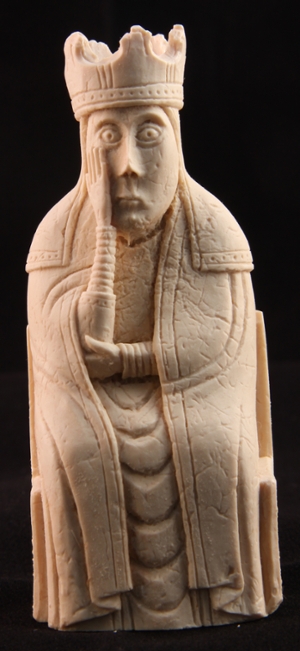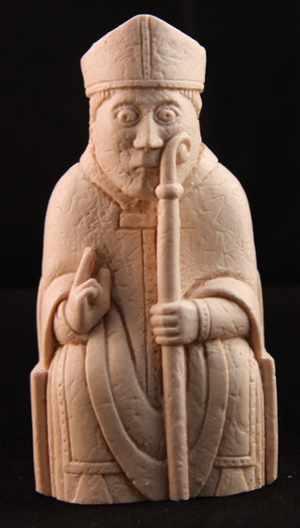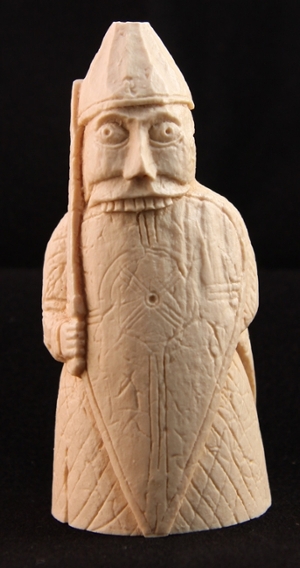Lewis Chessmen
King
replica: from the British Museum, London
donated by: Professor Sharon Wright and Lyla Wright
date of the original: 1150-1200 CE
provenance of the original: Uig, an area on the western coast of the Isle of Lewis in the Outer Hebrides, Scotland buried in a sandbank.
description: The Kings are all seated on highly intricate thrones, each holding a sword with both hands and resting it across his knees suggesting both the King's physical strength and unwavering justice. Drawing on the regal fashion of the time their hair is arranged in thick braids across their backs.
The "Norwegian argument," the belief that the Chessmen were crafted in Trondheim, Norway, is the most widely accepted theory pertaining to the origins of the Chessmen as it is supported by the most evidence. However, some scholars have recently found evidence that suggest the possibility of the Lewis Chessmen pieces having Icelandic roots.
Queen
replica: from the British Museum, London
donated by: Professor Sharon Wright and Lyla Wright
date of the original: 1150-1200 CE
provenance of the original: Uig, an area on the western coast of the Isle of Lewis in the Outer Hebrides, Scotland buried in a sandbank.
description: The Queens of the Lewis Chessmen collection are characterized by their long cloaks, crowns, and the sorrowful look on their face. They sit upon thrones with their head in their left hand as they supposedly watch over a battle, mourning over the destruction.
The "Norwegian argument," the belief that the Chessmen were crafted in Trondheim, Norway, is the most widely accepted theory pertaining to the origins of the Chessmen as it is supported by the most evidence. However, some scholars have recently found evidence that suggest the possibility of the Lewis Chessmen pieces having Icelandic roots.
Knight
replica: from the British Museum, London
donated by: Professor Sharon Wright and Lyla Wright
date of the original: 1150-1200 CE
provenance of the original: Uig, an area on the western coast of the Isle of Lewis in the Outer Hebrides, Scotland buried in a sandbank.
description: The Knights of the Lewis Chessmen collection are characterized as armoured men sitting astride miniature horses while bearing weapons. They display the armour and weapons used in the second half of the twelfth century in Norway.
The "Norwegian argument," the belief that the Chessmen were crafted in Trondheim, Norway, is the most widely accepted theory pertaining to the origins of the Chessmen as it is supported by the most evidence. However, some scholars have recently found evidence that suggest the possibility of the Lewis Chessmen pieces having Icelandic roots.
Bishop
replica: from the British Museum, London
donated by: Professor Sharon Wright and Lyla Wright
date of the original: 1150-1200 CE
provenance of the original: Uig, an area on the western coast of the Isle of Lewis in the Outer Hebrides, Scotland buried in a sandbank.
description: There are 16 Bishops from the Lewis chess piece hoard. The two we have here are shown wearing mitres, a ceremonial headdress of bishops, and they hold a hooked staff of office known as a crozier. While only one is enthroned they are both making a sign of blessing, are clean-shaven and wearing religious garments.
The "Norwegian argument," the belief that the Chessmen were crafted in Trondheim, Norway, is the most widely accepted theory pertaining to the origins of the Chessmen as it is supported by the most evidence. However, some scholars have recently found evidence that suggest the possibility of the Lewis Chessmen pieces having Icelandic roots.
Berserker
replica: from the British Museum, London
donated by: Professor Sharon Wright and Lyla Wright
date of the original: 1150-1200 CE
provenance of the original: Uig, an area on the western coast of the Isle of Lewis in the Outer Hebrides, Scotland buried in a sandbank.
description: The berserkers are one of the two types of rooks in the Lewis Chessmen collection. These pieces are often considered comic relief as they are characterized by their bulging eyes and biting of their shields. Berserkers, in Norse legend, were fighters who inspired great fear into their opponents because they were vicious and uncontrollable in battle.
The "Norwegian argument," the belief that the Chessmen were crafted in Trondheim, Norway, is the most widely accepted theory pertaining to the origins of the Chessmen as it is supported by the most evidence. However, some scholars have recently found evidence that suggest the possibility of the Lewis Chessmen pieces having Icelandic roots.
Warder
replica: from the British Museum, London
donated by: Professor Sharon Wright and Lyla Wright
date of the original: 1150-1200 CE
provenance of the original: Uig, an area on the western coast of the Isle of Lewis in the Outer Hebrides, Scotland buried in a sandbank.
description: The Warders are the second type of rook next to the berserkers. They are shown wearing helmets and defending themselves with shields decorated comparably to those of the Knights. They are represented as foot soldiers with a sword and shield in hand.
The "Norwegian argument," the belief that the Chessmen were crafted in Trondheim, Norway, is the most widely accepted theory pertaining to the origins of the Chessmen as it is supported by the most evidence. However, some scholars have recently found evidence that suggest the possibility of the Lewis Chessmen pieces having Icelandic roots.




